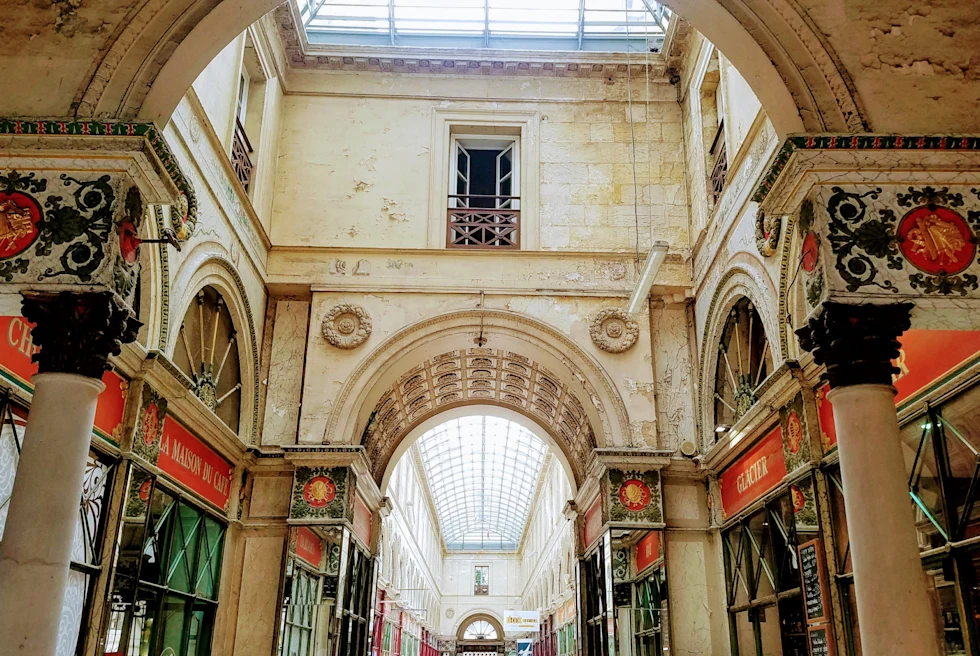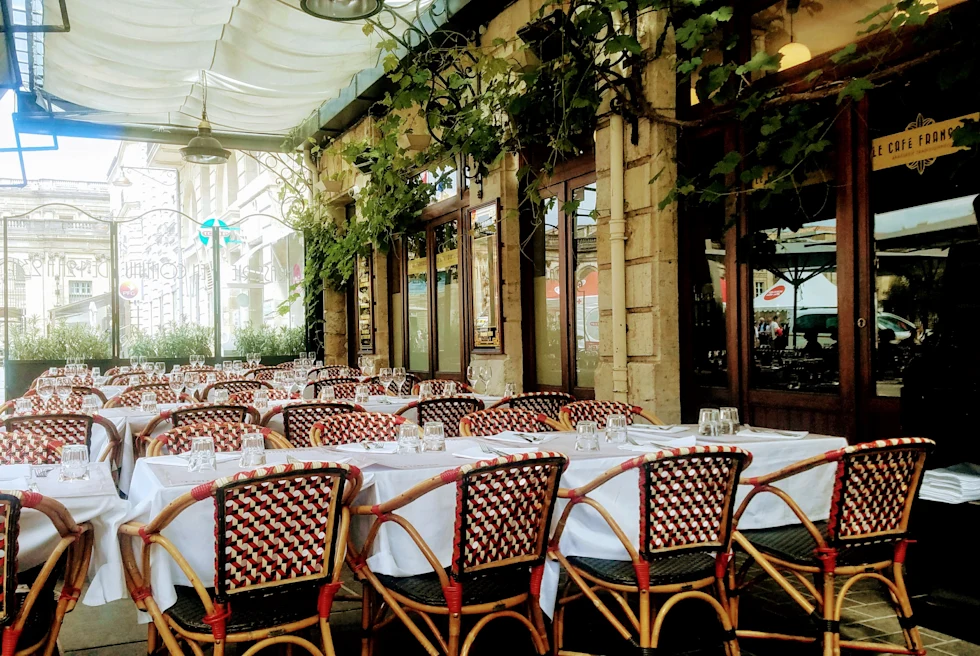
Curator’s statement
Once upon a time, Bordeaux was a sleepy, little town, slightly run down, without much to offer save some Medieval remnants, and a good location to launch a wine tasting experience in the region. Not so today. Now easily accessible in 2.5 hours by TGV (high speed train) from Paris, it has become a delightful city in its own right, which displays a beautiful mix of French, African and Spanish influence in the food, dress and neighborhoods. It boasts a newly accessible waterfront area and a modernized transportation system, the once-blackish building exteriors have been washed to reveal their natural stone color, restaurants and bars abound, shopping is abundant and, best of all, the character is still intact. On a trip to Bordeaux, you will find charm in the vegetation growing in the sidewalk cracks (there are even tours now precisely for this), a juxtaposition between the working fish market and the glitz of St. Catherine pedestrian street, students bustling around the square near the cathedral and many enchanting activities and cafés.
The Fora Difference
Book with Jody to access exclusive perks and experiences on your trip.
Killer perks
Free upgrades, spa credits and more—we got you
Personalized recs
Customized travel planning for your style
Insider knowledge
Expert advice from people who’ve actually been there
Where to stay Bordeaux, France
Unlock perks by contacting Jody to book your trip.
Things to do Bordeaux, France

La Cité du Vin: Accessible by tram, this museum covers wine in its entirety (save for the tasting of it, for which you will need to make a lunch reservation in the resto up top, or go across the street to the Bacalan). It covers the history, influence, making of, uses for and love of this liquid, through the use of high-tech, interactive displays, videos and art. It is extraordinary. Buy tickets in advance online to skip the line.
Bacalan market / Echoppe des Halles (see also Le Familia below) are across the street from the Wine Museum. Belly up to the fresh oyster bar, grab some foie or a strong coffee. It is small, but the food is top notch and a great grab for a picnic. (Stop by the newfangled “drawbridge” before you hop back on the tram to watch a ship pass below. It is sleek and modern, and a pride of Bordeaux, as the tallest vertical lift bridge in Europe. It’s a crowd stopper in spite of its almost invisible movement. Pont Jacques Chaban-Delmas).
Jardin Publique: This garden is walkable in 30 minutes, and absolutely charming. In the far reaches is a beautiful set of arches, hidden behind which is a cultivated, botanical garden area. Straddling the lake are several beautiful, arching bridges, willows dragging in the water and swans swimming underneath. Kids are often crawling over the playground and riding the twinkling, cheery carousel. The smell of magnolia blossoms in the summer will delight you, as will a stop at the café for a drink in the shade. Service here can be spotty, so don’t be in a hurry, and you will be asked (untypically of the French) to pay up front, as they have too many eat-and-runners. But the drinks are a respite from the heat (or cold) and it is a view that will replenish you and your weary feet. Note that not too far from the park, in the middle of a residential neighborhood, are the Roman ruins of Palais Gallien which, though not terribly well preserved, are still an educational sight/ site.
Cathédral Saint André is, as you might expect, from the stature as a national monument, a stunning example of Gothic architecture, flying buttresses and all, packed full of art and a bohemoth organ (I was lucky enough to happen in during a practice and it moved me to tears). Pope Clément V was made Archibishop of this Bordeaux in 1297 — stories of his executions of Knights Templar give rise to their existence here.
Waterfront reflecting pool: This used to be an area to avoid, especially since the cruise ships would “drop their loads” here. But it has been cleaned up, even to the point of grass being planted around the train tracks, and turned into an enjoyable area with bike and walking paths, flowers, benches, views of the opposite quai, and a shallow pool with only a veneer of water one might “walk” on, which reflects the surrounding buildings (created by the landscape artist Michel Corajoud).
Ste. Catherine walking area is a nice stroll, ending up at the Place de la Bourse and l’Opèra (also worth a pop-in if you have time). The shops are a tad too touristy for my taste, but if you are in a window-shopping mood, quite fun all the same. At the Bourse end of Ste. Catherine is the Galerie Bordelaise, a beautiful, covered gallery walk. It’s worth a stop to see the elaborate decorations.
La Grosse Cloche (1795), and Porte Cailhau (1495) are pieces of history you may walk under during your stroll around town. They are magnificent memorials to the medieval history of Bordeaux, one used as a jail, the other as a defensive batîment.
Quinconces Fountain: One of the highlights of this town, situated in a large, open five-pointed “square”, made to symbolize the Republic, the revolutionary effort and the role of the Girondins. It is the largest city square in all of Europe. Much of this bronze fountain was destroyed by the Nazis in WWII, but was restored in the 80’s to its current glory. Note that the tram hub is located here.
Marché des Capucins: Named after the Capuchin monks, is the largest market in Bordeaux. If you want to see it pulsing with activity, go in the early morning. This is not a tourist spot, but rather a true locals’ locale for buying the freshest produce, flowers, meat, dairy and fish. The floor will be wet, the place will have a strong odor and the people are so real you will want to belly up to a coffee bar just to watch the show.
Take a trip up the St. Michel Tower for a little exercise to see the bells and the view. This tower is one of a few in Bordeaux that was built independently from the church to avoid collapsing the church from its weight. The mechanism of the bells is open and worth the trip, but don’t miss the haunted crypt, which made its way into a Victor Hugo literary references for its mummies. After your workout, find a nice café in the surrounding market area, which bustles most days with flea markets, and weekends with a full local produce market.
St Michel food market: Come to watch an incredible mix of cultures.
WWII Memorial: While this is a tad out of the way for the normal tourist beat, if you have an interest in seeing the cemetery where the mummies from the St. Michel crypt are buried, or are headed to Le Coq or La Cocotte (both recommended) for lunch, make a stop here. You will see a different part of Bordeaux, the working area, the business area, and a moving memorial to veterans and Holocaust victims.
If you have extra days to see wine country, of course, do!
Places to eat & drink Bordeaux, France

On your way back to town from the Cité du Vin (assuming you haven’t filled up at the Bacalan market), head to this literal hole in the wall, Salle a Manger des Chartrons (make a reservation). It is situated down a long, quiet, residential street, and no, you haven’t made a mistake, just make sure you have the address. The room of a few rustic wooden tables feels a bit like a wine cave, with an open prep bar and oven at the far end. It is special. A chalkboard menu of five or six daily specials is all you should expect. Among us, we ordered almost everything on it and every bite was delicious. The Chef spent time in Italy and combines her French/Italian senses with whatever is fresh and best that day, served in cast iron pans. It is just lovely. The owner is gracious, proud, and humble. We will go back every time we visit.
Puy Paulin: We kept finding ourselves here. In a super location, just off the walking street of Ste. Catherine, the tables outside on a small square will beckon. Inside the marble topped bar, yellow tiled floor, guilded ceiling decorations, and cozy tables only fit a few lucky customers. You will be presented with a little can of “rillettes” at the start of your visit. The menu offers a range of treats from beef Carpaccio to oysters. Our wait staff was young and new, so perhaps be patient with service, as they are eager to please. (On a side note, the same restaurant group also owns La Familia, out by the Musee du Vin).
Familia Brasserie is an open floor plan room with a modern but cozy warehouse feel. Glass on all sides, a beautiful bar in the middle and friendly waiters make this a wonderful post-museum visit stop.
Brasserie Bordelaise: Steak, steak and more steak, with some lovely Parma first. The back room is a quite the hidden gem; as you wander back from the main dining room, you will find yourself peering down a floor, over another dining room, an open kitchen and bustling atmosphere (the front room is a bit quieter).
Café Français: In the shadow of Church, next to the Hotel de Ville. Traditional interior for colder days. Fantabulous people watching on the square. Frequented by students and tourists alike.
La Tupina: A highlight of this city. It oozes history and Bordeaux pride (in a nice way). Bistro chairs and cobblestone-street seating out front offer a warm day option, but the rustic, yellow-toned, almost centuries-past market-feeling interior is a lovely respite on a cold or very hot day. The fresh cuts of meats, breads, and produce displayed as you enter are a treat for the eyes and nose, and give a hint of the joy your tongue is about to experience. The wood-burning fireplace replete with cast iron pot, flowers on the tables, tile floors, country-linen table cloths, family photos on the wall and a remarkable photograph of the “last supper” of famous French chefs all make you feel as if you just walked into a distant aunt’s country French cottage. Sounds of birds tweeting keep you company in the bathroom and the staff shatters the French reputation of haughtiness in their niceties. Food is mostly Southwestern French. Menu is appropriately limited in size, and expertly done.
Le Coque: This is the kind of place I never would have found without suggestion. It is small, locals only, and the food is a gift — simple ingredients turned into a great meal. If you happen in to be in the area of the war memorial or the cemetery, this restaurant is worth a small detour, if for its authenticity alone.
Bistro du Musee: One of favorite meals of our trip because the food was a notch above any other we tried (with the exception of La Tupina), and the casual atmosphere and easy location next to the cathedral, in a bustling area, gave us plenty to look at and talk about. Light stone walls, wooden tables, wine openers and vines as decoration, but a contemporary airy feel all the same. Regional dishes such as duck and foie, alongside some lighter fare. Don’t miss this spot.

A note from Jody
Don't miss trying a Bordeaux specialty, the canelé, a small pastry with a caramelized exterior and soft interior with a vanilla or rum flavor. Oh, and the wine!....

Travel Advisor
Jody Holman

Get in touch with Jody
Did you like this guide? Reach out to customize and book your own experience. Or, just to chat about travel in general.
You can expect a response from Jody within 1–2 business days. You’ll also be subscribed to our traveler newsletter (you can unsubscribe at any time).
For more France travel tips — especially for those of you traveling with kids — take a look at my complimentary France guides: The Ultimate Family-Friendly Trip to Paris, France and Family-Friendly Trip to Normandy, France.